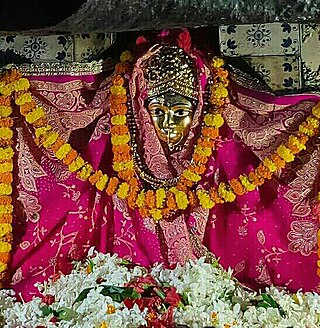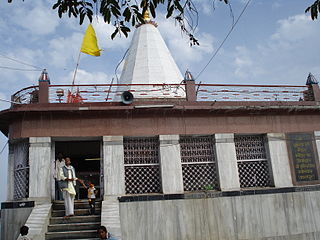
The Shakta pithas, Shakti pithas or Sati pithas are significant shrines and pilgrimage destinations in Shaktism, the mother goddess denomination in Hinduism. The shrines are dedicated to various forms of Adi Shakti. Various Puranas such as Srimad Devi Bhagavatam state the existence of a varying number of 51, 52, 64 and 108 Shakta pithas of which 18 are named as Astadasha Maha (major) in medieval Hindu texts.
Ambaji (Ambājī) is a census town in Banaskantha district in the state of Gujarat, India.

Jawalamukhi, or Jwalamukhi also Jawalaji, is a temple town and a nagar parishad in Kangra district in the Indian state of Himachal Pradesh. Hindu genealogy registers are kept here like that of Haridwar. The town takes its name from the holy Jwalamukhi Temple, located in Jawalamukhi. Firuz Shah Tughlaq during his campaign of Nagarkot destroyed the temple and desecrated its main deity. He stole 1300 Sanskrit Manuscripts from this temple's library that was later translated into Persian language, becoming the first Sultanate administration to do such translation.

Tripura Sundari Temple is a Hindu temple of the Goddess Tripura Sundari, better known locally as Devi Tripureshwari the third mahavidya & main form of Parvati. The temple is situated in the ancient city of Udaipur, about 55 km from Agartala, Tripura and can be reached by train and road from Agartala. It is believed to be one of the holiest Hindu shrines in this part of the country and witnesses the highest number of visitors for a temple in North-East India, after Kamakhya Temple in Assam. The state of Tripura is named after this temple. Popularly known as Matabari, the shrine is set upon a small hillock that resembles the hump of a tortoise (Kurma). This shape called Kurmapṛṣṭhākṛti is considered the holiest possible site for a Shakti temple, hence also bestowing the name of Kurma Pīṭha. The Goddess is served by traditional Brahmin priests.

Chintpurni is a small town in the Una district of Himachal Pradesh about 40 km north of Una, not far from the border with the Indian state of Punjab. The elevation is about 977 meters. It is home to the Maa Chintpurni Temple which is a major pilgrimage site as one of the Shakti Peethas in India. The Hindu genealogy registers at Chintpurni, Himachal Pradesh are kept here. North of Chintpurni are the western Himalayas. Chintpurni lies within the much lower Shiwalik range.

Guhyeshwari Temple, also spelled Guheswari or Gujeshwari, is one of the revered holy temples in Kathmandu, Nepal. This temple is dedicated to Guhyeshwari or 'Nairatma' yogini, one of the important yoginis in Buddhism. The temple is also a Shakti Peetha and it's about 1 km east of Pashupati Kshetra and is located on the southern bank of the Bagmati River. It is an important pilgrimage destination especially for Tantric worshipers. King Pratap Malla renovated this temple in the 17th century.

Surkanda Devi is a Hindu temple near Kanatal, Uttarakhand, India. It is at an altitude of about 2756 metres lies close to nearby hill stations of Dhanaulti and Chamba walking distance of approx 3 kilometres [1.9 mi] from Kaddukhal, the place where vehicles are parked.

Tara Tarini Mandir is a Hindu temple of Adi Shakti at the Kumari hills on the bank of Rushikulya river near Purushottampur in Ganjam district of Odisha, around 28km from Brahmapur city.

Chandranath Temple, located on top of the Chandranath Hill, is a famous Shakta pitha located near Chittagong in Bangladesh where, as per Hindu sacred texts, the right arm of Deiti Sati fell. Chandranath Temple is a pilgrimage site for Hindus. Its height about 1,020 feet (310 m) above sea level.

Bhabanipur is a Hindu temple complex in northwestern Bangladesh located about 33 kilometres (21 mi) from Bogra. It is located in Sherpur Upazila of Bogra District, Rajshahi Division. It is one of the Shakti Pithas of the Indian subcontinent.

Manikarnika Ghat is one of the holiest cremation grounds among the sacred riverfronts (ghats), located on the banks of River Ganga, in the city of Varanasi in the Indian state of Uttar Pradesh. In Hinduism, death is considered a gateway to another life marked by the result of one's karma. It is believed that a human's soul attains moksha, and hence breaks the cycle of rebirth when cremated here.

Chandika Sthan is a Hindu temple situated in Munger, in the India state of Bihar. It is one of the fifty-one Shakti Peethas, places of worship consecrated to the goddess Shakti. On the Northeast corner of Munger, Chandika Sthan is just two kilometers away from the Munger town. Being a Siddhi-Peetha, Chandika Sthan is considered to be one of the most sacred and sanctified temples, as important as the Kamakshya temple near Guwahati. Sati's left eye fell here and it is believed that those who worship here get rid of eye pain. It is one of the major Hindu pilgrimage centre in Ang Pradesh region of Bihar.
Shri Shri Mahalakshmi Bhairabi Griba Maha Peetha is one of the Shakta pithas, at Joinpur village, Dakshin Surma, near Gotatikar, 3 km south-east of Sylhet town, Bangladesh. The Hindu Goddess Sati's neck fell here. The Goddess is worshipped as Mahalakshmi and the Bhairav form is Sambaranand.
Sugandha Shaktipeeth, a temple of the Goddess Sunanda, is located in the village of Shikarpur, 10 miles north of Barisal, in Bangladesh. This Hindu temple is one of the Shakti Peethas.

The temple of Attahas, is believed to be one of the 51 Shakti Peethas at which the body parts and jewelry of the Hindu goddess Shakti fell to Earth. The goddess is so large that the lower lip is about 15 to 18 feet wide. The temple is a site of Hindu pilgrimage throughout the year. December is a particularly popular time for visitors to picnic at the site.

Kottiyoor Vysakha Mahotsavam is an annual 27-day Hindu pilgrimage that commemorates the mythological Daksha Yaga. Similar to the Kumbh Mela of Prayag, this festival involves ritual ablutions. The vicinity is not called a temple because there are no permanent structures. Instead, a temporary hermitage built with Palmyra leaves is found and addressed as Yajna Bhoomi. Kottiyoor is revered as Dakshina Kasi.

Dakṣayajña is an important event in Hindu mythology that is narrated in various Hindu scriptures. It refers to a yajna (ritual-sacrifice) organised by Daksha, where his daughter, Sati, immolates herself. The wrath of the god Shiva, Sati's husband, thereafter destroys the sacrificial ceremony. The tale is also called Daksha-Yajna-Nasha. The legend forms the liturgical basis of the establishment of the Shakti Pithas, the temples of Mahadevi, the supreme deity of Shaktism. It also becomes a prelude to the legend of Parvati, Sati's reincarnation, who later marries Shiva.

Maa Tara Chandi Temple is a Hindu temple dedicated to Maa Shakti or Maa Durga, located in Sasaram, Bihar, India. It is one of the 51 Shakti Peetha.

Nandikeshwari Temple, also known as Nandikeshwari Tala, is located in Sainthia city of West Bengal. This temple is part of the famous Shakti Peethas in Indian Subcontinent.

Maa Sharda Temple is a Hindu temple of Goddess Sharda in Maihar district of Madhya Pradesh in India. It is believed that Goddess Sharda is the incarnation of Goddess Saraswati. This temple is one of the Shakti Peethas of Goddess Bhavani. It is believed that even today, Alha visits the temple to worship Goddess Sharda.
















